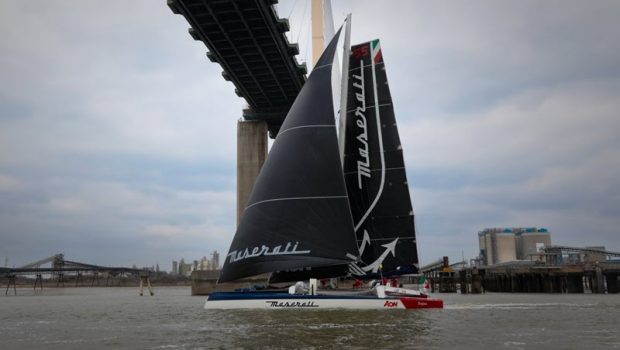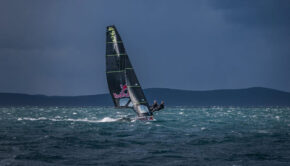Maserati sets new Tea Route record
Published on February 23rd, 2018
(February 23, 2018) – Giovanni Soldini and the crew on the trimaran Maserati Multi 70 have broken the 13000 nm record from Hong Kong to London, setting a new unofficial time of 36 days, 2 hours, 37 minutes, and 2 seconds.
Finishing today at 13:20:26 UTC, Soldini and his team of Guido Broggi, Sébastien Audigane, Oliver Herrera Perez and Alex Pella passed under the Queen Elizabeth II Bridge to complete the classic Tea Route course.
The team started from Hong Kong on January 18 to beat the record set in 2008 by Lionel Lemonchois on board the 100 footer maxi catamaran Gitana 13 (41 days, 21 hours and 26 minutes). Maserati’s finish time improves the record by 5 days and 19 hours, traveling 15083 nautical miles at an average speed of 17.4 knots.
“We are super happy but also very tired,” said Soldini. “The last 48 hours have been very tough. Sailing in the Channel upwind with a lot of breeze, a lot of sea and a terrible cold.
“But the record went very well, we are very happy with our route. The most difficult part was the last one: with more favorable weather conditions in the Atlantic we could have gained another 3 or 4 days, but that’s okay.
“Technically the boat is perfect. From the last time we put Maserati Multi 70 in a yard, we have sailed more than 19000 miles and everything is fine onboard, surely there is the work of preparation by Guido and the whole team. An excellent crew.”
The official time will be ratified by the World Sailing Speed Record Council.
Review the team’s route here: maserati.soldini.it/cartography
Day by day summary of the Tea Route Challenge:
Jibing in the South China Sea
After the start on January 18th, on the first two days, the crew took advantage of the NE wind, making a series of jibes to get closer to the southern tip of Vietnam. On the third day, a first transition with little wind off Singapore is negotiated. On the fourth and fifth day, the crew still sails with light winds to pass the Sonda Strait and enter the Indian Ocean with a two-day advantage on Gitana 13.
Full throttle in the Indian Ocean despite everything. On the sixth day, the first in the Indian Ocean, a tropical depression localised in the South West of Sumatra. From the seventh to the ninth day, Maserati Multi 70 sails downwind at high speed on the direct route in the south-eastern trade winds of the southern hemisphere, recording the best sailing day with 644 miles travelled in 24 hours.
On the tenth day the right hull’s rudder breaks following a collision with a floating object. On the eleventh day, the broken rudder blade is replaced. The progress of Maserati Multi 70 reaches its lowest level falling below 250 miles. On the twelfth day, the route comes out of the trade winds range and passes a high-pressure neck. The three following days are characterized by the passage of three cold fronts. Maserati Multi 70 reaches the southernmost latitudes of the route, around 38°S. The Cape of Good Hope is passed on the sixteenth day with a five-day lead over Gitana 13.
South Atlantic along the African side
The South Atlantic climbing begins downwind. On the nineteenth day the eastern option is decided upon to cross the Equator. From the twentieth to the twenty-third day, Maserati Multi 70 heads to West Africa following a direct route, crossing off the Gulf of Guinea. The Equator is passed on the twenty-second day. The Maserati Multi 70reaches its maximum advantage – a 2.046 mile lead.
An unusual route also in the North Atlantic
An unexpected light breeze bubble slows the landing in Sierra Leone on the twenty-third day. The doldrums and a stationary tropical depression near the coastline must be passed through. The situation of the Azores high pressure remains atypical, it is quite impossible to avoid it passing to the West, the eastern option goes on. From the twenty-fifth to the thirtieth day, Maserati Multi 70 makes several tacks along the coast of West Africa up to the Canary Islands. The advantage remains stable at around 1,200 miles.
On the thirty-first day, upwind sailing against a NE breeze phase begins; Maserati Multi 70 is getting closer to the coast of Portugal. The boat sails very fast in the second part of the Bay of Biscay crossing.
The English Channel upwind and the Thames downwind
Maserati Multi 70 enters the English Channel before dawn on 22 February. The thirty-fifth day of navigation begins between Cornwall and Brittany and continues towards the southern coast of England, before resuming the tacking sequence along the coastline, with a freezing cold wind to negotiate. The following day, early in the morning, the trimaran enters the Strait of Dover and turns the south-eastern end of England to go up the Thames estuary up to the Queen Elizabeth II bridge. The finish line is crossed on February 23rd at 13.20 UTC.
Maserati Multi 70 Boat Configuration
For this record, the team returned the Maserati Multi 70 trimaran to its original configuration with classic appendages that come with the MOD70. The foil, i.e. the daggerboards and rudders that have been developed and built in the last few months that allow the boat to rise from the water, remained on land. “For this record, we decided to go back to a non-flying setting, above all to limit the risk of impact with objects at sea,” explained Soldini. “We have doubled the number of photovoltaic panels on board. This will allow us to gain weight and be autonomous from an energy point of view – a fundamental aspect in long navigation like this one.”
Maserati Multi 70
Length: 21.20 m
Beam: 16.80 m
Weight: 6,300 kg
Sail Area (upwind): 310 mq
Sail Area (downwind): 409 mq
Source: Maserati team









 We’ll keep your information safe.
We’ll keep your information safe.